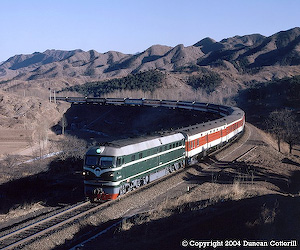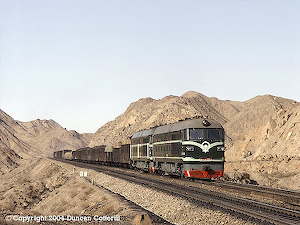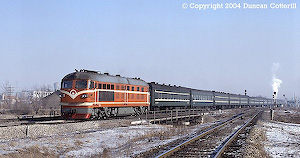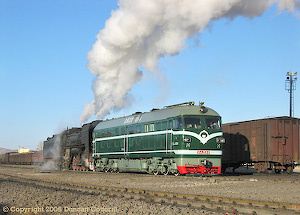DF4, DF4A, DF4B Class Co'-Co' Diesel-Electrics
The DF4 can be regarded as China's standard main line diesel locomotive. It's more a family of related designs than a single class, with a number of significant variants identified by suffixes; DF4B, DF4DK etc. The original DF4, the DF4A and DF4B are all outwardly similar in appearance and all carry numbers in the DF4 series without the A or B suffix. The generic term DF4 is often used to refer to the original DF4, the DF4A or the DF4B. As the locos were generally used interchangeably, this practice will be followed here.
Although there is a passing similarity to the Soviet M62, both classes are products of the period after Soviet technical assistance ended and closer inspection shows numerous differences between them. The DF4 is recognised as a Chinese design, albeit one heavily influenced by European and American practice.
The locos are double ended Co-Co diesel-electrics powered by a 2430 kW / 3250 HP, 16 cylinder "V" engine that appears to be based on North American 4-stroke practice. The mechanical design was heavily influenced by the Henschel NY5 class diesel hydraulics imported in 1966 and includes the use of pivotless bogies. Tractive forces are transmitted between the bogies and the loco body by means of external links. This method has since been used in a number of Chinese designs.
A close up of a DF4 bogie showing the link that transmits tractive forces between the bogie and the loco body. The primary suspension shows Alsthom influences.
DF4 construction began at Dalian in 1969. The first 108 locos, fitted with the 16V240ZJ engine, took seven years to produce. In 1976 the improved 16V240ZJA engine was adopted and locos from DF4 0109 onwards were classified DF4A. Around 660 were produced at Dalian until 1984 when production switched to the DF4B. Again, the DF4B was virtually indistinguishable from the previous models but was fitted with a further improved 16V240ZJB engine.
Around the time of the switch to the DF4B model, production increased dramatically with Dalian building around 1700 DF4B over the next 10 years. Other works also became involved. Ziyang constructed a few DF4A before switching to DF4B production and building around 1500 locos. Datong also built around 500 and Sifang turned out a handful. In recent years, Ziyang has continued to produce small numbers, primarily for local railways and industrial operators.
The start of DF4B production in the mid 1990s marked the beginning of full scale dieselisation in China. Although diesel locomotives had been built or imported since the late 1950s, the requirements of a rapidly expanding network far outstripped the supply of new diesels. The shortfall was made up by building thousands of QJ class 2-10-2s and JS class 2-8-2s.
The DF4B changed all that. Production rates increased dramatically from tens to hundreds of units per year and diesels began to displace steam from the national system. Although other diesel classes were produced in this period and a number of lines were electrified, the most significant factor was the widespread introduction of several thousand DF4B. By the late 1990s steam working had become the exception rather than the rule and the DF4 could be found virtually anywhere on the network.
The standard DF4 / 4A / 4B has a maximum speed of 100 km/h. It was primarily intended as a freight loco but many DF4 were used to haul passenger trains including expresses. This practice has become less common in recent years as the number of dedicated passenger classes has increased.
A small number of DF4 or DF4A were built specially for passenger work and were geared for 120 km/h operation. From 1987, Dalian built almost 600 DF4B with the same 120 km/h passenger gearing. These passenger engines are all numbered in the DF4 2xxx series and can usually be distinguished by their distinctive orange livery. The vast majority of 100 km/h locos carry a green livery with white, cream or pale blue lining
Few of the original DF4 remain in traffic, although DF4 0001 has an assured future as an exhibit at the Beijing Railway Museum.
However, DF4A and DF4B are still in widespread use and can be seen in main line service all over China. Industrial and local railways have acquired a number of redundant machines from CNR while others have been built new for the sector. Production continues in small batches as this is written in early 2006.




